
|
| Ale
Houses, Pubs and Taverns
A look at their development and place in the community
- An article by Christine Forbes nee Lloyd |
Introduction
Renowned the world over, the great British pub is not just a
place to drink beer, wine, cider or even something a little bit
stronger - it is a unique social centre, very often the focus
of community life in villages, towns and cities throughout the
length and breadth of the country. However, this is changing with
the closure of many pubs in recent years.
It appears that the great British pub actually started life as
a great Italian wine bar, and dates back almost 2,000 years. It
was an invading Roman army that first brought Roman roads, Roman
towns and Roman pubs known as tabernae to these shores in 43 AD.
Such tabernae, or shops that sold wine, were quickly built alongside
Roman roads and in towns to help quench the thirst of the legionary
troops.
Ale however was the native British brew, and it appears that these
tabernae quickly adapted to provide the locals with their favourite
tipple, and the word eventually became corrupted to tavern. The
native British brew of ‘ale’ was originally made without
hops. Ale brewed with hops was gradually introduced in the 14th
and 15th centuries; this was known as beer. By 1550 most brewing
included hops and “alehouse” and “beerhouse”
became synonymous. Today beer is the general term with bitter,
mild, ales, stouts and lagers simply denoting different types
of beer.
These taverns or alehouses not only survived but continued to
adapt to an ever changing clientele, through invading Angles,
Saxons, Jutes and both Danish and Scandinavian Vikings. Around
970 AD one Anglo-Saxon king, Edgar, even attempted to limit the
number of alehouses in any one village. He is also said to have
been responsible for introducing a drinking measure known as ‘the
peg’ as a means of controlling the amount of alcohol an
individual could consume, hence the expression “to take
(someone) down a peg”.
Taverns and alehouses provided food and drink to their guests,
whilst inns offered accommodation for weary travellers. These
could include merchants, court officials or pilgrims travelling
to and from religious shrines, as immortalised by Geoffrey Chaucer
in his Canterbury Tales.
Inns also served military purposes; one of the oldest dating from
1189 AD is Ye Olde Trip to Jerusalem in Nottingham, and is said
to have acted as a recruitment centre for volunteers to accompany
King Richard I (The Lionheart) on his crusade to the Holy Lands.
Alehouses, inns and taverns collectively became known as public
houses and then simply as pubs around the reign of King Henry
VII. A little later, in 1552, an Act was passed that required
innkeepers to have a licence in order to run a pub.
Throughout history, ale and beer have formed a part of the staple
British diet, the brewing process itself making it a much safer
option than drinking water. Although both coffee and tea were
introduced into Britain around the mid-1600s, their prohibitive
prices ensured that they remained the preserve of the rich and
famous. Just a few decades later however, things changed dramatically
when cheap spirits, such as brandy from France and gin from Holland,
hit the shelves of the pubs. The social problems caused by the
‘Gin Era’ of 1720 – 1750 are recorded in Hogarth’s
Gin Lane. The Gin Acts of 1736 and 1751 reduced gin consumption
to a quarter of its previous level and returned some semblance
of order back to the pubs.
The age of the stagecoach heralded yet another new era for the
pubs of the time, as coaching inns were established on strategic
routes throughout the country. Such inns provided food, drink
and accommodation for passengers and crew alike, as well as changes
of fresh horses for their continued journey. The passengers themselves
generally consisted of two distinct groups: the more affluent
who could afford the relative luxury of travelling inside the
coach, and the others who would travel outside. The ‘insiders’
would of course receive the warmest greetings and be welcomed
into the innkeepers private parlour or salon (saloon); the outsiders
meanwhile would get no further than the inn’s bar room.
The age of the stagecoach, although relatively short-lived, did
establish the precedence for the class distinctions that followed
with rail travel from the 1840s onward. Like the railways that
operated a First, Second and even Third Class service, so the
pubs evolved in a similar manner. Pubs of that time, even relatively
small ones, would typically be split into several rooms and bars
in order to cater for differing preferences of the differing type
and class of customer.
By 1577 it is estimated that there were some 17,000 alehouses,
2,000 inns and 400 taverns throughout England and Wales. Taking
into account the population of the period, that would equate to
around one pub for every 200 persons. The number of public houses
per capita most likely peaked in the late 19th century and has
been falling ever since, although the industry saw a temporary
recovery after the Second World War. By 1969, there were 75,000
pubs in the UK, a number that fell gradually to 69,000 by 1980,
finally slipping below the 60,000 mark for the first time in 2003
and the decline in numbers continues.
This pattern can be followed in Glasbury, which was well provided
with at least 8 pubs in the village during the 19th century. Of
these, the only one still functioning as a pub is the Harp Inn
– the rest have disappeared or become private dwellings,
apart from the Maesllwch Arms Hotel which has metamorphosed into
Foyles Glasbury.
|
| The
Pubs of Glasbury - on the Radnorshire side
The Maesllwch Arms : -- ( now re-named Foyles
Glasbury ).
The original building dates from the 18th century
and has been considerably altered over the years, even before the
most recent changes which were completed in 2015.
Until the 1950s the bar was in the central section of the building
– in fact where it is now following the latest renovation.
Early photographs show large barn doors, later replaced by windows,
which must have opened on to the bar. The public bar was moved to
the south side of the building and the original bar area made into
a dining room which was lined with oak panelling taken from Maesllwch
Castle. The panelling extended into what became the lounge bar which
had a large, ornate fireplace (still in situ), also taken from the
Castle. An upstairs assembly room was used for functions and dances
– a concert was held here to celebrate the Queen’s coronation
in 1953 – but was converted into bedrooms soon afterwards.
In 1841, according to the census return, the landlord was Henry
Joliffe (born on the Isle of Wight) who is listed with his wife
and 1 house servant. In 1841 Mr Joliffe provided a dinner for the
Maesllwch Estate tenants at a charge of £29.5s.0d which included
dinner for 62 tenants, a bottle of brandy, a bottle of gin, 2 bottles
of sherry wine, 36 bowls of punch, 60 glasses of spirits and water,
beer, tobacco and entertainment. A good time had by all!
In the 1851 to 1881 census returns, Richard James is the landlord;
he was born in Northamptonshire. In 1851 he is listed as Innkeeper,
along with his wife (born in St. David’s Pembrokeshire) and
2 house servants, both born locally. In 1871 he is listed as Innkeeper
and Farmer and in 1881 he is listed as Innkeeper and Farmer of 10
acres. It seemed that all the innkeepers had a second occupation.
In 1931 The Maesllwch Arms had “accommodation for 15 persons
for one night or longer, a garage with room for 2 cars and stabling
for 2 horses”.
The Arms, as it was known in the village, belonged to the Maesllwch
Estate until around 1960 when it was sold to H.P. Bulmer Ltd. who
put in a series of managers. This was a period of success for the
hotel. It was very popular in the 1950’s and 1960’s,
particularly with fishermen, who came to Glasbury to take advantage
of the Wye and its plentiful salmon.
Bulmers sold the Maesllwch Arms in the 1970s and between then and
the present day it has had a chequered history - at one time boarded
up after the owners were bankrupted and local gossip talked of conversion
to an old people’s home. Fortunately, it was resurrected and
became once more very popular, particularly for Sunday lunch, when
run by Rob and Carol Taylor and then Ian and Carol Birch, who eventually
sold to a large pub chain ( Enterprise Inns ) in 2005. Once again
a series of managers were in charge and this was the beginning of
a gradual decline which ended with its sale at auction.
After a major renovation by the new owners, the Maesllwch Arms is
now a hotel and restaurant, renamed Foyles Glasbury and opening
on July 1st 2015.
It is now the only licensed premises on the Radnor
side of the village.
The Lamb Inn: --
Now a private dwelling, this building also dates
from the 18th century. In 1815 David Jones appeared as the landlord
in a list of pubs which entered into recognisances to “keep
and maintain good order and not suffer any disorder or unlawful
games to be used”. He was still landlord in 1825 when he paid
£30 for his alehouse licence, but in 1826 and 1827 the licence
was paid by William Michael and in 1828 by John Burgwyn.
The 1841 census return names the landlord as Thomas Jones, a butcher
as well as innkeeper. In 1851 the landlord is listed as Edward Evans
who was born locally, in Aberllynfi, living with his wife, 2 sons
and 1 house servant. In 1861 he is still there with his wife, 1
son, 2 house servants and a boarder: Thomas Jones, aged 90, a former
schoolmaster who was in charge of Coed-y-Bolen school between 1816
and 1837.
By 1871 the landlord has changed and is now Benjamin Williams who
was formerly The landlord of the Swan Inn. The Lamb remained with
the Williams family until 1911, the last year for which census records
are available.
The Lamb was the headquarters, according to an article in the Brecon
& Radnor Express dated June 1911 of “Court Lily of the
Forest (no. 6028 Herefordshire district)” of the Ancient Order
of Foresters which is a benevolent Society dating back to the 15th
century. Court Lily of the Forest organised athletic sports meetings
in the village in the early years of the 20th century.
At the start of the 20th century the Lamb was owned by the Hereford
& Tredegar Brewery. The licensee from 1921 was Robert Fernie,
whose wife was, at that time and until the early 1950s, the licensee
of the Maesllwch Arms. In 1931, at a hearing of the County Licensing
Committee, the Lamb was described as consisting of a tap room, bar,
kitchen, scullery, pantry, store room and cellar (all the walls
of which were said to be damp), together with 3 bedrooms, sitting
room and club room. Outside was a barn, a three-stall stable, pigsty,
2 bucket closets in the garden and a concrete urinal. Mr Fernie
told the committee that “trade was very little, did not average
a barrel a week” and that “profits were not sufficient
to keep him”. The company said that it had spent £465
on renewals and repairs and had built a new kitchen. Trade in 1928
was 91 barrels of beer (drawn by hand from the barrel) and 55 gallons
of wines/spirits; in 1930 it was 53 barrels of beer and 38 gallons
of wines/spirits. Renewal of the licence was refused and the Lamb
closed.
The Swan Inn : --
The site, on the village green, is now occupied
by a private dwelling. The Swan Inn, originally 2 old thatched cottages,
is not mentioned in the licensing records up to 1829 but in the
1841 census it is listed as a public house with Benjamin Williams,
born in Llandefalle, as the landlord. He was also a master blacksmith,
employing 3 men and in the 1861 census return he is listed with
his wife, 3 children, an apprentice blacksmith and Benjamin, his
80 year-old father who was a former innkeeper.
In 1871 Benjamin moved to the Lamb Inn and the new landlord was
Thomas Jones. It would appear that soon afterwards the Swan ceased
trading as a public house since in the 1881 census it is listed
as Swan Cottage, with a carpenter called John smith and his family
living there.
In 1922 the old thatched building was demolished and replaced by
a wooden bungalow which was again replaced in 2006 by the present
house.
.
The Plough and Harrow : --
Now a private dwelling. Built in the 18th century
and a pub in 1789, the Plough and Harrow belonged to the Maesllwch
Estate. In 1827 and 1828 the licence was granted to Thomas Kitchenman
who was also a glazier and who died in 1834 aged 41. He has a fine
memorial stone in St Peter’s churchyard.
The Plough and Harrow stood on what used to be the road from the
village up to Ffynnongynnydd. This road became a private drive to
Maesllwch Castle when the Estate built, circa 1840, a new road connecting
the village and Ffynnongynnydd,. Presumably, this was the time when
the Plough and Harrow ceased trading and became Harrow Lodge or
Harrow Cottage, since, according to the 1841 census, James Watkins,
a carpenter, lived there with his wife and family and 1 servant.
At some point an addition was made to the side of the property nearest
the village and this became the Estate office. During the Second
World War the house was used as a base by the local Home Guard.
The Pubs of Glasbury on the Breconshire
side
The Harp Inn : --
The Harp Inn is a traditional country Inn which
dates from around 1720. The building’s use as a public house
is recorded in auction sale details dated 1796 and it may have started
life as a cider house. Situated on the road to Hay, and not far
from the crossing point over the Wye, it would have benefited greatly
from passing trade.
In 1841 and 1851 the innkeeper was William Davies, born in Glasbury,
who was also a musician. He was followed in 1861 by William Williams,
in 1871 by John Davies, in 1881 by James Davies, in 1891 by Annie
Lewis, in 1901 by Williams Davies and, prior to 1911, by William
Curtis Morgan.
One evening in July 1866 an injured man called John Williams was
taken to the Harp Inn after being struck in the chest by a piece
of timber near Glasbury railway station. Mr Williams, of Hay-on-Wye,
worked for a timber merchant and was unloading a timber carriage
when the accident happened. A Talgarth surgeon who was in the neighbourhood
rushed to the Harp Inn to help, but Mr Williams died.
Inquests were sometimes held at the Harp Inn. In 1913 the jury returned
a verdict of accidental drowning on five-year-old Oscar Morgan,
second son of Mr and Mrs Jenkin Morgan of Glasbury. The child had
been “playing ships” with another boy at a pool on the
Grove when he over-reached and fell into the water. He was buried
at St Peter’s Churchyard.
Licensing records from 1909 show that the pub’s registered
owners were Arnold Perrett and Company, of Wickwar, Gloucester,
with William Curtis Morgan the licensee. In 1919 he was fined £2
10s for selling spirits in the bar without displaying the maximum
price, and the same amount again for selling spirits for more than
the “maximum controlled price”.
Prior to major changes carried out in the 1960s, there was a dark,
low ceilinged public bar to the left of the building where the dart
board is now, a top bar which was rarely used apart from when the
local youths persuaded Bill Price, the landlord, to allow them to
play cards there and an off-licence window which was situated to
the right of the current front door. A rear garden with pig sties
to one side is now a large car park.
Brian and Jean Potter enlarged and modernised the building during
their ownership, ably followed by Dave and Linda White, making the
Harp more or less the pub we know today. Happily for the village,
the Harp is still very much a going concern and central to village
gatherings in the very capable hands of Grahame and Jayne Day
The Six Bells :--
This was situated to the east of St Peter’s
church, just below the tram line , in a field for which planning
permission is currently being sought (2017) to build several houses.
It disappeared many years ago although its outline is still currently
visible in the field. In 1815 it was included in a Licensing Authority
list, and, like the Lamb Inn, agreed to “keep and maintain
good order, and … not suffer any disorder or unlawful games
to be played”. At that time, and until 1827, John White was
the licensee.
In 1841 the licensee was William Honeyfield, born in Gillingham
in Dorset, and also described as a wool sorter - yet another example
of innkeepers having a second occupation. The woollen mill at Treble
Hill provided work for many in the village until its closure in
about 1860.
William is listed as landlord between 1851and 1871. In 1841 and
1851 his occupation is given as woolsorter/innkeeper whereas in
1861 he is now, as well as an innkeeper, a wool stapler employing
3 men. He died in 1877; his widow continued to live in the village
until her death in 1892.
The Six Bells does not appear on the census returns after 1871;
presumably it closed with the death of William in 1877.
The Castle Inn : --
This pub was situated on the B4350 road to Hay,
somewhere between Broomfield and the Harp. In 1841 and 1851 the
landlord was Edward Gwynne who was also a master saddler. He lived
there with his wife and 4 children, a saddler apprentice, a house
servant and, in 1851, 2 timber surveyors and a horse dealer. Presumably
the latter 3 were paying guests.
In 1861 Edward Gwynne, still listed as a saddler, was living at
Grove House with his family and in 1871 he was living in Chapel
House but no mention is made of the Castle Inn in census returns
after 1851. Could the Inn have become a private dwelling? Could
it have been damaged by, for example, fire? No more is known about
this pub. Edward Gwynne died in 1879.
Others : --
Also mentioned in the alehouse licences granted
in Glasbury were the Hammer and Trowel and the
Mason’s Arms. In 1823 and 1824 the licensee
of the Hammer and Trowel was Ann Berry. In 1825 the licencee is
listed as Thomas Kitchenman for Ann Berry. Ann Berry died on 21st
May 1825, which is probably why Thomas Kitchenman was standing in
for her. He was granted the licence for the Hammer and Trowel in
1826, but in 1827 he is listed as the licencee for the Plough
and Harrow. The Hammer and Trowel disappears in the licensing
records after 1826 but the Masons Arms appears, licensee James Harris.
Could it be the same pub but with a change of name?
In the 1950s Glasbury House was
a Country Club, opening on Sundays. In this way the locals who were
members no longer had to cross the border into England for their
Sunday drink. Pubs were closed in Wales on Sundays from 1880, following
pressure from the temperance movement and non-conformist chapels,
until a change in the licensing laws in 1961 allowed each county
to vote on the question of Sunday opening.
|

The Maesllwch in the 1890's, showing
the double doors
Photo from the Battiscoombe collection
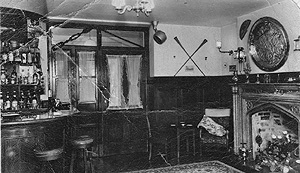
The Maesllwch Lounge and ornate fireplace 1950's
Courtesy of Christine Forbes ( nee Lloyd )
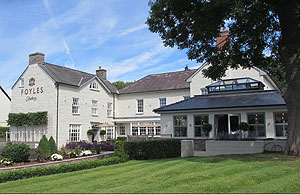
Foyles Glasbury -shortly after
it's opening
B Bowker - 02.07.2015
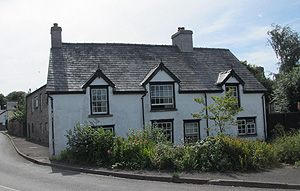
Lamb House, formally The Lamb Inn
B Bowker - 02.07.2015
"July 19th 1928- Mr
R. Fernie of the Lamb Inn lectured this afternoon to classes 1
and 2 on his voyage to and life in the Falkland Islands."
( From Ffynnon-Gynydd School log book )
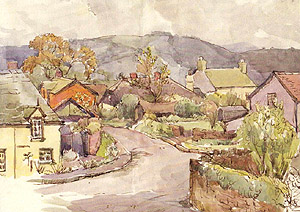
A watercolour of Glasbury in the
1970's, depicting
Lamb House on the left, Maesllwch Arms on the right
and centre stage is the old Blacksmiths shop
Courtesy of Elizabeth Fry
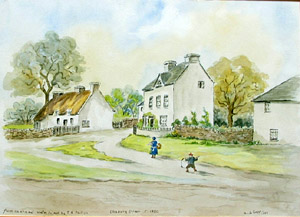
The Swan Inn circa 1880, on the
left, in a watercolour
by Ursula Cooper from an original by T R Philips
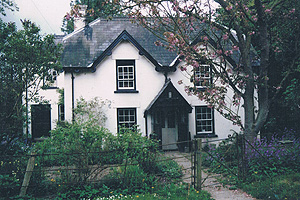
Harrow Lodge, formally the Plough and Harrow
Photo courtesy of Chris Forbes, nee Lloyd
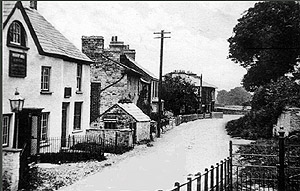
The Harp Inn in the early1900's
Courtesy of Paul Greenow
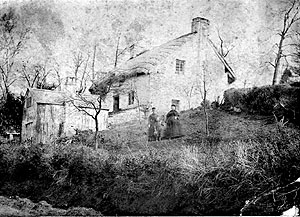
A rare photograph of the Six Bells
in 1878
Courtesy of Brigid Edlin ( nee Cooper )
|
Further information
on Glasbury pub landlords and families, obtained from Census Returns
and parish registers.
The Castle Inn
: --
Edward Gwynne, the landlord in 1841 and 1851 was born in Glasbury
and was a master saddler. He married Jennet Jenkins on 6th April,
1832 by special licence. They had 4 children: Henrietta born in
1832 (baptised 15th July); Caroline born circa 1834; William born
circa 1838 and Anne born circa 1842.
Jennet died sometime prior to 1871 as in this census Edward is
listed as a widower and is living in Chapel House with his daughters
Henrietta Kitchingman, a milliner, and Anne Jones, together with
his granddaughters, Ada Gwynne Kitchingman, aged 5, born in London
and Caroline Jennet Jones, aged 2, born in Birmingham and his
grandson George Edward Jones, aged 2 months born in Birmingham.
In 1841 Edward had an 18 year old apprentice living with him at
the Castle Inn – Thomas Kitchingman. Thomas was baptised
in St. Peter’s Church on 30th September, 1822, and was the
son of Thomas and Mary Kitchingman, sometime licensees of the
Plough and Harrow. I presume that he was the husband of Henrietta.
Edward Gwynne died in 1879.
The Harp Inn : --
The landlord in 1841 and 1851 was William Davies who was born
in Glasbury and was also a musician. He is listed as living with
his wife, Anne, born in Llandeilo and his children, Mary Anne,
born circa 1837, son John born circa 1842 and Elizabeth born circa
1846 – all children were born in Glasbury. In 1861 he has
left the Harp and is living at no. 1 Grove Cottage, and his occupation
is given as basket maker and musician.
1n 1861 the landlord was William Williams, who was also a shoemaker,
born in Aberedw, living with his wife Elizabeth, born in Bredwardine
and children William, born circa 1854 in Hay, daughter Mary Anne,born
circa 1856 in Boughrood and son John, aged 1 month, born in Glasbury.
In 1871 the landlord was John Davies, aged 36, a plumber and glazier
as well as innkeeper; born in Glasbury and living with his wife,
Harriet, and 3 children, all of whom were born in Glasbury.
In 1881 the landlord was James Davies, aged 56, born in Droitwich,
living there with his wife, Jane, born in Builth and their daughter,
Jessie, aged 22, also born in Builth.
In 1891 the Harp had a landlady, Annie Lewis, single, aged 32,
born in Pembrokeshire. She is living there with Eleanor McCarthey,
a servant, who was born in Llandewi, Radnorshire.
In 1901 the landlord was William Davies, aged 34, born in Tredegar,
living with his wife, Mary, and a servant, Constance Watkins aged
18 who was born in the village. William was blind.
In 1911 the landlord was William Curtis Morgan, aged 34, born
in the Rhondda Valley, living with his wife Minnie Jane and 3
children aged from 1 to 7, all born in the village, and a servant,
Alice Swainscott, aged 23 and also born in the village.
The Lamb Inn : --
In 1841 the landlord was Thomas Jones, born circa 1821, with his
wife Catherine, his 16 week old daughter Mary, and 1 servant.
In 1851 and 1861 the landlord was Edward Evans, born circa 1811
in Aberllynfi, living with his wife Mary, 2 sons and 1 servant.
In 1871 Benjamin Williams moved to the Lamb from the Swan with
his wife, Sarah, son William who is aged 16 and a blacksmith,
his daughter, Sarah, aged 14, 2 servants and an apprentice. He
was still the landlord in 1881 but in 1891 his son, William had
taken over as landlord and was still there in 1901 with his wife
Anne, daughter, Frances, his brother in law, Evan and 1 servant.
By 1911 William was dead and his wife, Anne, was in charge, living
there with her daughter, Frances Ammonds and her son-in-law John
Ammonds (an ironmonger). The Ammonds had been married for 2 years
and had one child who had died.
Mr Robert Fernie was the landlord from 1921 and on 19th July,
1928, he gave a talk to the children in classes 1 and 2 of Ffynnongynydd
School regarding his voyage to, and life in, the Falkland Islands.
The Maesllwch Arms : --
In 1841 the landlord was Henry Joliffe, born circa 1791 on the
Isle of Wight, living with his wife, Elinor, born circa 1801 in
Builth and a servant, Celia Jones. Henry retired somewhere between
1841 and 1851 and in 1861 was living in Talgarth with Elinor and
Celia, now listed as his niece and still a servant. In 1871 Elinor,
a widow, was back living in the village near the Maesllwch.
Between 1851 and 1881 the landlord was Richard James, born circa
1816 in Pitsford, Northants, living with his wife, Jane, born
around the same time in Pembrokeshire, 2 children, a niece, a
nephew and various servants. Richard is listed as innkeeper and
farmer.
In 1891 and 1901 the landlord was John Morgan, born circa 1855
in Crickhowell, innkeeper and plumber, living with his wife Ann,
born in Penybont, sons William, Henry, Richard, Arthur and Charles,
and daughter Anne. William, the eldest son, was born in the Rhondda
Valley and in 1901 his occupation was given as butler.
In 1911 the landlady was Elizabeth Harper, a widow aged 57 born
in Wells in Somerset, living with her daughter Edith Elizabeth,
aged 20, born in Herefordshire and Ernest Catchpole a boarder
aged 20, a chauffeur born in Hounslow.
The Swan Inn:
In 1851 and 1861 the landlord was Benjamin Williams, born circa
1816 in Llandefalle, also a master blacksmith employing 3 men,
He is living with his wife, Sarah, born in Clifford and his children:
Thomas also a blacksmith, William and Sarah who were all born
in Glasbury. In 1861 he also has his father, another Benjamin
and a former innkeeper living with the family.
In 1871 the landlord was Thomas Jones, born circa 1804 in Llandewi
Fach, living with his wife Catharine, born in Hereford, and daughter,
Annie, aged 18, a scholar, and son Charles aged 10.
The Six Bells : --
In 1816 the landlord was John White, an innkeeper
and butcher.
From 1841 until 1871 the landlord was William Honeyfield, born
circa 1809 in Gillingham, Dorset, living with his wife, Elizabeth,
born in Glasbury, daughters Ann, Elizabeth, Margaret, Grace Eleanor,
Priscilla Mary and sons William, John and James. He was an innkeeper
and wool sorter, later a wool stapler. He died in 1877.
In 1881 his wife, Elizabeth and daughter, Priscilla, a dressmaker,
were living in Wye Cottage, near Glasbury bridge. In 1891 they
were living in Cwmbach. Elizabeth died in 1892.
In 1871 William’s daughter Margaret was a domestic servant
in Great Malvern, and in 1881 she was a maid in Upton on Severn,
Worcestershire. In 1901 she was back in Glasbury, living in the
Old Vicarage with her sister, Priscilla. In 1911 she was living
in Melbourne House with her sister Elizabeth Ammonds, a widow
of private means, and the latter’s daughter, Gladys Emily,
aged 26 and single (see below*). Margaret died on 25th May, 1946
at the age of 99. At this time she was living with her sister,
Priscilla, in Green House on the Green. She left estate worth
£4,559-11s-4d. ** Priscilla died on 6th January, 1951 at
the age of 95 and left estate worth £2,981-14s-6d**
In 1869 William’s daughter, Elizabeth, married Thomas Ammonds
(born in Glasbury). In the 1861 census both Elizabeth (a house
servant and shop assistant) and Thomas (a butcher) were living
and working on the Radnorshire side of the village, in the house
of John Ardern who was a butcher and grocer. After their marriage
they left Glasbury and kept a shop in Bedwellty, Monmouthshire,
but in 1881 they were back in Glasbury, living with their 5 children
at The Shop. This was situated I believe, where Grangeton is today
and was a village shop until the 1960s. Of their 5 children, Gladys
Emily*, born circa 1885, was a pupil teacher at Ffynnongynydd
School in 1899. In 1946 she married the Rev. Fred Whitehead and
lived at Melbourne House until her move to Cartref in Hay, where
she died in April 1984 at the age of 99.
Thomas Ammonds, died in June 1903, leaving estate worth £2,561-2s-7d**;
Elizabeth in May, 1935, aged 92.
** Equivalent values: in 1903 £1,000 equated to £112,000
in today’s values (2017)
in 1946 £1,000 equated to £29,000 in today’s
values (2017).
In 1951 £1,000 equated to £22,000 in today’s
values (2017).
Christine Forbes 11.07.2017
Sources
: --
Census returns and parish
registers.
Documents held in Powys County Archive
“The Pubs of Radnorshire” by Tony Hobbs
“The Great British Pub” by Ben Johnson
Back to top of Page
|
| |
|








